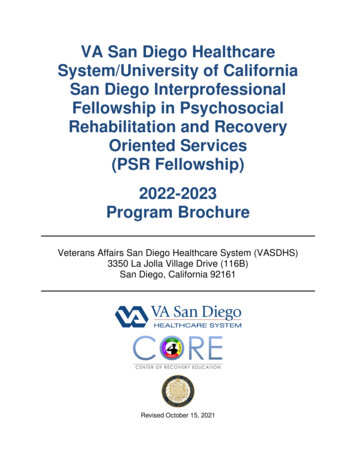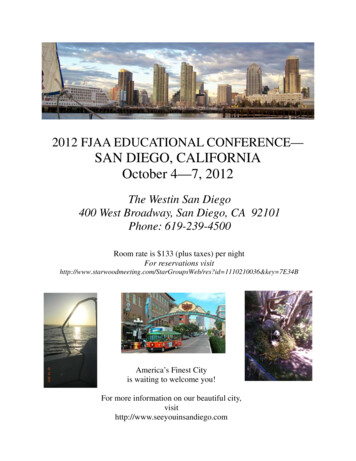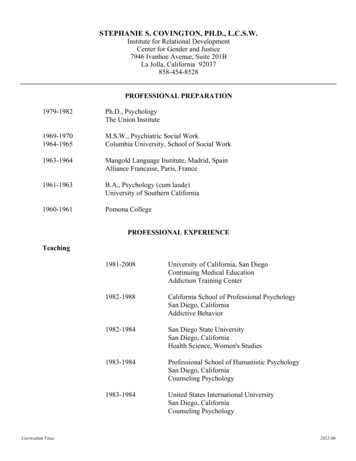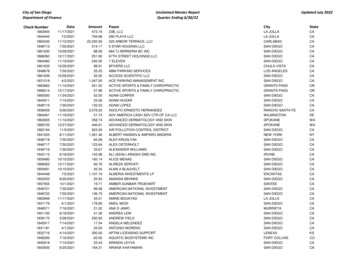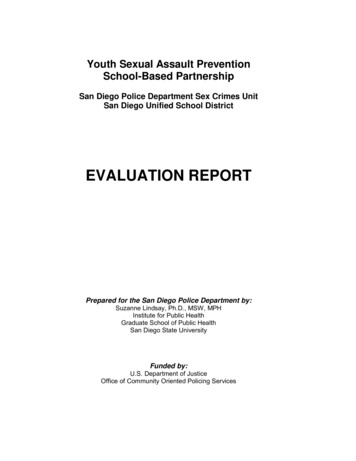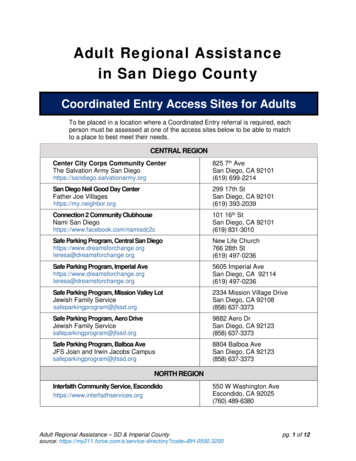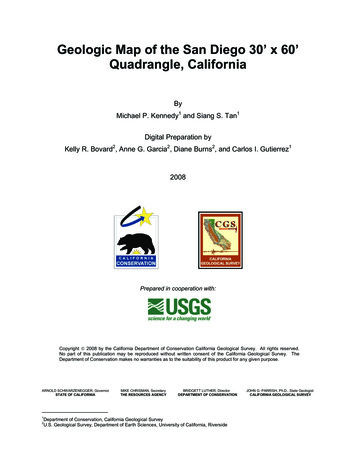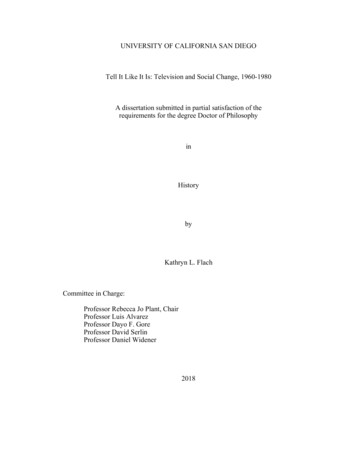
Transcription
UNIVERSITY OF CALIFORNIA SAN DIEGOTell It Like It Is: Television and Social Change, 1960-1980A dissertation submitted in partial satisfaction of therequirements for the degree Doctor of PhilosophyinHistorybyKathryn L. FlachCommittee in Charge:Professor Rebecca Jo Plant, ChairProfessor Luis AlvarezProfessor Dayo F. GoreProfessor David SerlinProfessor Daniel Widener2018
Kathryn L. Flach, 2018.All rights reserved.
The Dissertation of Kathryn L. Flach is approved, and it is acceptable in qualityand form for publication on microfilm and electronically:ChairUniversity of California San Diego2018iii
DEDICATIONFor my family—Fred, Marylee, Ulices, and Emilioiv
EPIGRAPH“It’s not what they said, it’s how they said it.”-Marie Petrucelliv
TABLE OF CONTENTSSignature Page. iiiDedication . ivEpigraph . vTable of Contents . viList of Figures . viiiAcknowledgements . ixVita . xvAbstract of Dissertation . xviiiIntroduction . 1Historiography . 5Chapter Outline . 14Chapter 1 The Moral Medium: Television and the New Frontier . 19“A Global Village in a Box” . 23Television’s Nadir . 32Television’s New Frontier . 38Educational Entertainment . 45Chapter 2 Windows and Mirrors: Educating the Public Through Realistic Drama . 52The War on Ignorance. 57The High School Dropout: Exile on Main Street . 69Authenticity vs. Realism: The Limits of Representing Race . 78The Not-So-Silent Dissuaders . 96Chapter 3 “This is Education?”: Solving American’s Race Problems withIntegration Television . 121Who is Angela Davis and Julia? . 126“Black Is The Color Of Our New TV” . 132Not in My Living Room!: Integration TV . 136Representation and Reverse Discrimination . 149Sponsoring Race . 166Chapter 4 “Think Real, Think Poverty, And Think Fun”: From Problem Solving toProblem Consciousness. 172vi
Social Relevancy in the 1970s . 176“Workshop Forges Ghetto Talent” . 188Good Times in Moynihan’s Shadow . 199A Ghetto Enlightenment . 209Chapter 5 Flippin the Script: Learning about Sexism Through Introspection. 222Narcissism, Self-Help, and Cultural Psychology in the “Me Decade” . 227Mary Hartman, Mary Hartman: Between Feminist and Total Woman . 233Consumer Consciousness and America’s Nervous Breakdown . 244Chairwomen and Househusbands in All That Glitters . 256Epilogue . 268Bibliography . 274vii
LIST OF FIGURESFigure 1: Illustration from Jack to Hal Kanter . 2Figure 2: Newspaper article on Angela Davis torn out of the San Diego Union by acontemporary with Julia on the flip side. 123viii
ACKNOWLEDGEMENTSI am fortunate to have received encouragement and support from family, friends,mentors, and colleagues throughout this long education journey. I can honestly say,though, that I would not have made it to this Ph.D. program if it were not for two peoplein particular. The first is George Farris, the trustee for the Dorothy Hassenflue SteinScholarship who gave me a chance to go to college at the University of Akron. Aftergraduating from high school I did not think that I was smart enough to go to college, so Iam eternally grateful that he gave me the opportunity to prove myself wrong. The secondperson was my undergraduate mentor and M.A. advisor at the University of Akron, TJBoisseau. She helped me get into a graduate program, spent endless hours helping me tobecome a better writer, and most importantly answered questions I did not even know toask as a first-generation college student.At UCSD I have also received guidance and inspiration from numerous facultymembers. My advisor, Rebecca Jo Plant, has been extremely supportive since I enteredthe Ph.D. program. I am grateful for all the thoughtful comments and critical feedback onmy written work. But most of all, her encouragement over the last seven years has helpedme see this project through to the end. In addition to the support she provided me when Iwas in San Diego, I am extremely grateful that she took the time to “meet” with me overthe phone multiple times after I moved to Colorado. Graduate school can be isolating, butit’s even more so when you move away from your community during the last year of aPh.D. program. At UCSD, I have also had the pleasure to work with Luis Alvarez. As acommittee member, he provided me with guidance on my research and professionalix
development, and his insightful questions throughout the years have pushed me to thinkabout my project differently. I have also learned a great deal about teaching fromwatching him and I try to put this into practice when I teach my own classes. Mymeetings with Danny Widener at the Art of Espresso coffee cart were a great source ofinspiration. His guidance, kindness, and advice on navigating the job market and life ingeneral has been invaluable. I am also grateful for the overwhelming support I havereceived from David Serlin. He met with me regularly over the past few years, and hisenthusiasm for my project has always been so reassuring—I always felt excited andmotivated to forge ahead with this dissertation after we had a conversation. I would alsolike to thank Dayo Gore for her comments on my prospectus, which helped me to thinkabout the possibilities of this dissertation leading into the research phase of this process.Other faculty members at UCSD and elsewhere have contributed to myintellectual, and professional trajectory. At UCSD, I would like to thank Nayan Shah andRachel Klein for their thoughtful feedback in the seminars I took with them. At the 2017American Historical Association, Natasha Zaretsky offered useful comments on an earlydraft of my fifth chapter and our conversations have always been fruitful in helping me totake a step back and think about the bigger picture of my research. I have also hadproductive conversations with Jessica Weiss and Alison Kibbler at multiple conferences.Their comments on my work and professional advice has always been extremely helpful.I am especially grateful for the archivists and librarians who helped me locate andaccess the source material for this project. The staffs at the Wisconsin State HistoricalSociety, University of California, Special Collections, Southern California Library forSocial Studies and Research, and the Bancroft Library Special Collections were veryx
generous with their time and expertise. Special thanks to the archivists at the Universityof Wyoming’s American Heritage Center who suggested materials that were not on myradar based on my research interests, and for mailing additional materials for free after Ileft Wyoming. Also, Julie Graham at UCLA’s Special Collections provided helpfulinformation about various media archives in the greater Los Angeles area. ArchivistsChristopher Kox at City College of San Francisco and Pamela Jackson at San Diego StateUniversity went above and beyond to help me search for what little information I have onthe Minority Writers Workshops that I wrote about in my fourth chapter, and I cannotthank them enough. Many thanks to Norman Lear who allowed me access to his personalcollection, but even more so to his secretary, Jean Anderson, who was so kind and madethe arrangements for me to view his papers—she even sent me two episodes of All ThatGlitters on DVD for no reason other than she thought it might help.This project would not have been possible without the generous funding fromUCSD’s Department of History Research and Travel Grants and the ChancellorsInterdisciplinary Collaboratory Fellowship. The Frontiers of Innovation ScholarshipProgram helped facilitate the completion of this project.I am fortunate to have had such a strong support system with the friends I made atUCSD. Mary Klann is one of my closest friends, her optimism and drive inspire me. Shehas probably read my work more than anyone, with countless fellowship and jobapplications, conference papers, and chapter portions. I cherish our friendship andcouldn’t imagine going through this program without her. I am grateful for MychalOdom’s kindness and intelligence. Our conversations before and after seminars pushedme to be a better scholar. Mychal was also an extremely supportive friend when my dadxi
passed away, and for that, I am so thankful. Cameo Lyn West was my study partner whenpreparing for our qualifying exams, and I was fortunate to have a friend who had to go tothe same archive as me. There are few people in this world who could make a five-hourdrive from Los Angeles to San Diego enjoyable, and she is one of those people. Specialthanks to Manuel Morales Fontanilla, James Deavenport, David Idol, and MicheleBrewster who have all challenged and encouraged me to become a better scholar andteacher.I would also like to thank Andrew Ditto for burning my first CD when we workedtogether at the Italian deli when I was in high school. I could tell he was surprised whenhe asked me which album I wanted, and I gave him a list of my favorite television themesongs. He told me it took longer than expected since Barney Miller, Maude, Good Times,and The Jeffersons were probably not top downloads on Napster in the late 1990s. But hefound all the songs and even made a sticker of the Welcome Back, Kotter cast to put onthe cover. I still have that CD and I listened to many times while writing.Most important, my deepest love goes to my family who have provided endlesssupport since I can remember. My grandfather, John Petrucelli, was a role model andtaught me the importance of being kind to people. My grandmother, Marie Petrucelli,encouraged me to work hard and pursue my education. My father, Fred Flach, was mybiggest cheerleader and a constant source of love and support. My mom, Marylee Flach,has shown me by example how to be a fantastic parent, and now as an adult I considerher my friend. She is fun, smart, caring, and a true inspiration. She’s also a great researchassistant. When helping me at the archive in Wisconsin, she held up a piece of fan mailxii
and loudly proclaimed, “can you believe Twitter replaced this?” She brought a lot of funto that research trip.My extended family have also been a support system who helped me to finish thisdissertation. My uncle and aunt, Pete and Mary Herschberger, drove me to and from theairport numerous times and opened their home to me while on research trips, and for nonresearch related visits. The long phone conversations with my aunt, however, and thebond we share is what I love most. Elisabeth Brown and Michael and Elena Herschbergerbring so much joy and happiness to my life whenever we are together, they helped metake much needed breaks to enjoy spending time with family throughout this process.Rocky Petrucelli and Jeff Kezman are the two people who make my trips back to Ohiothe most fun because of their sense of humor and spirit. Furthermore, I cannot thank mymother-in-law, Maria Piña, enough for welcoming me into the family and showing muchkindness. I had one chapter completed before I had my son, Emilio, and it was becauseshe came to Colorado twice for extended visits that allowed me to make significantprogress on this dissertation. I was able to be away from home and focus because I knewEmilio was in good hands. I cannot thank her enough for sacrificing her time away fromher own home to help me and taking such good care of Emilio.Emilio has brought so much joy to my life and has been the greatest distraction.His constant smile and affection brought happiness to long and tiring days spent writingat the library. Although I started this journey long before Emilio entered this world, in theend I was motivated to finish for him as much as I was for me. Most of all, I give mythanks to my husband, Ulices Piña. He has helped me grapple with intellectual ideas, readcountless drafts, and encouraged me during moments of self-doubt. But more importantlyxiii
he has helped me to relax and enjoy life more. This is probably because he is someone Itruly enjoy living my life with. He is my best friend and the love of my life. Ulices alsosacrificed a lot of his own work time to give me the space I needed to finish thisdissertation. He stayed at home with Emilio, cooked meals, and toward the end, he evengot up every night to tend to Emilio so that I could feel rested during the final stages ofdissertation writing. Sleep is a beautiful thing.xiv
VITAEDUCATION2018Doctor of Philosophy in History, University of California San Diego.Chair:Rebecca Jo PlantMajor Field: Modern United States HistoryMinor Fields: Women’s/Gender History, Communication.2011Master of Arts in History, University of Akron.2007Bachelor of Arts in Education, University of Akron.PUBLICATIONS“Julia.” in Women’s Rights: Reflections in Popular Culture, ed. Ann Savage. SantaBarbara: ABC-CLIO, 2017.Review of M. J. Rymsza-Pawlowka, History Comes Alive: Public History and PopularCulture in the 1970s (Chapel Hill: University of North Carolina Press, 2017), in theJournal of Popular Culture (forthcoming).FELLOWSHIPS AND AWARDS2017Frontiers of Innovation Scholars Program (FISP) Fellowship, Universityof California San Diego.2016Summer Graduate Teaching Scholars Program, University of CaliforniaSan Diego.2016Research Travel Grant, Department of History, University of CaliforniaSan Diego.2015Research Travel Grant, Department of History, University of CaliforniaSan Diego.2014-2015Head Teaching Assistant Award, Department of History, University ofCalifornia San Diego.2012-2014Chancellor’s Interdisciplinary Collaboratory on Gender InequalityFellowship, Graduate Studies Department, University of California SanDiego.xv
2011-2015Graduate Studies Fellowship, Department of History, University ofCalifornia San Diego.2009-2010Graduate Studies Fellowship, Department of History, University of Akron.2009Presentation Award, Conference for Undergraduate and Graduate StudentResearch, University of Akron.2001-2007Dorothy Hassenflue Stein Scholarship, University of Akron.INVITED TALKS2016“Feminism on Television” invited lecture in COMM 144: AmericanTelevision in the 1970s, University of California San Diego, La Jolla, CA,May.2015“Looking Natural: The Iconic Image and Legacy of Angela Davis,”Featured guest lecturer before Angela Davis’ keynote address, PurdueUniversity, Lafayette, IN, February.CONFERENCE ACTIVITY/PAPERS2017“Angela Davis vs. Julia: Television’s Dichotomous New Black Woman,1968-1970,” Berkshire Conference on the History of Women, Gender, andSexualities. Hofstra University, Hempstead, NY; presenter.2017“‘The Silent Dissuaders’: The Politics of Feminist Television Writers inThe Sixties and Seventies,” Western Association of Women Historians49th Annual Conference. Town & Country Resort and Convention Centerin San Diego, CA; presenter.2017“A Feminist Script: Ann Marcus and the Politics of Writing for MaryHartman, Mary Hartman,” American Historical Association Conference.Colorado Convention Center, Denver, CO; presenter and panel organizer.2016“Is Studying Women Not Enough Anymore?: The Future of Women’sHistory,” Western Association of Women Historians 48th AnnualConference. Sheraton Denver Downtown in Denver, CO; panel organizer.2015“Covering Feminism as a Less Than Newsworthy Crusade, 1968-1970,”Western Association of Women Historians 47th Annual Conference.Hilton Sacramento Arden West in Sacramento, CA; presenter.xvi
2015“Teaching Diversity in UC San Diego Undergraduate Classrooms,”Teaching Diversity Conference. University of California, San Diego, LaJolla, CA; roundtable presenter.2013“Subliminal Messages: Televisual Portrayals of Feminism, 1968-1972.”Gender Beyond Boundaries 1st Annual Conference. University ofCalifornia, San Diego, La Jolla, CA; presenter.2012“Feeling Bad: Cultural Narratives of Guilt Across the Lifespan,” NationalWomen’s Studies Association. Oakland Marriott, Oakland, CA;moderator.2012“She Can Be the Mother: Televising Black Motherhood from Mamie Tillto Julia,” Southwestern Social Social Science Association Conference.The Manchester Grand Hotel in San Diego, California; presenter.2011“The Historical Legacy of Black Women’s Leadership FacultyRoundtable” in Honor of Angela Davis, University of Akron, Akron, OH;roundtable presenter.2010“Exposing Motherhood: Mamie Till and Televised Femininity,” GraduateCommittee for Research on Women/Gender 3rd Biannual Conference.University of Akron, Akron, OH; presenter.2009“Lynching Exposed: Televisuality and the Murder of Emmett Till,”Association for the Study of African American Life and History 94thAnnual Conference, Hilton Cincinnati Netherland Plaza, Cincinnati, OH;presenter.2009“Lynching Exposed: Televisuality and the Murder of Emmett Till,”Conference for Undergraduate and Graduate Student Research, Universityof Akron, Akron, OH; presenter.xvii
ABSTRACT OF THE DISSERTATIONTell It Like It Is: Television and Social Change, 1960-1980byKathryn L. FlachDoctor of Philosophy in HistoryUniversity of California San Diego, 2018Professor Rebecca Jo Plant, ChairThis dissertation investigates the relationship between popular culture and socialmovements during the 1960s and 1970s. In an era marked by the rise of movements thatchallenged discrimination and second-class citizenship, TV producers attempted torepresent and address societal tensions through the creation of more “realistic”programming that dealt with hot button social issues. With Black Power and feminism atthe forefront of these movements, white male producers sought out underrepresentedwriters—people of color and white women—to translate their experiences to the smallxviii
screen. This increased politicization in television engendered anxieties among reactionaryviewers who complained that sitcoms and dramas could disrupt the status quo bypresenting race and gender advancements in a positive light. Fans who wrote to networks,however, conversely claimed that Americans could learn from “authentic” shows that“tell it like it is.” Drawing on a wide range of sources—production files, correspondence,fan mail, script drafts, magazines, TV series, and writers meeting minutes—I argue thatproducers and viewers alike considered entertainment programming a tool that could altersocial and political discourse.Scholars of US social movements typically focus on what motivated people toorganize and the extent to which they achieved their goals. Analyses of the relationshipbetween activism and media are generally limited to the ways in which print andbroadcast news propelled or undermined a movement’s agenda. Studying periods ofresistance through the lens of popular culture, however, contributes to our understandingof how everyday people outside of social movements and from various racial and ethnicbackgrounds understood the changes that activists demanded. Tell It Like It Is placesentertainment television at the center of this dialogue to demonstrate how the politicizedcontext in which television shows were produced and viewed during the 1960s and 1970scontributed to the general public’s engagement with current events.xix
IntroductionIn September of 1970, producer Hal Kanter received a letter from an old friend,Jack, which read more like a stand-up comedy routine than a personal note. At one point,Jack described his reaction to catching a late night airing of the Dick Cavett Show andasked, “Does ANYONE watch TV? or are millions of sets turned on (or kept on) as asort of blanket background rather like an optical Muzak?” The question got at the heartof debates about television programming that dated back to the medium’s infancy,referencing arguments that claimed TV provided nothing more than mindlessentertainment. But Jack knew that television was far more than an innocuous distractionfrom life. Sandwiched between an update on his wife’s career and a diatribe about thetriteness of TV’s infatuation with doctors and detectives, Jack drew an illustration of awhite man wearing a hard hat, watching television from a chair surrounded with beercans. The man angrily yells at the television directly in front of him, but the image isdrawn so that only the backside of the television is visible, making the man himself thefocal point. The caption, a quotation from the symposium the man is watching on TV,reads: [T]elevision—while not educating in the strictest definition of the word—is, perhaps, performing the greatest educational service in our history—inshowing man the complexities of his world; in breaking down oldprejudices which have been slowly nurtured in ignorance and isolation—lessening tension and abating the poisons of bias which have kept wallsbetween nations; chasms between races—and made fellow-men strangers toone another.The illustration and caption reference the divisions that existed concerning television’ssocial and political role in the mid-twentieth century. From its earliest stage, debatesensued about whether television should function as an educational or entertainment1
medium. Jack’s drawing depicts this tension with the TV set projecting one side of theargument, as voiced by certain producers, writers, and even political figures, who claimedthat the medium could and should influence social and political discourse. The angrywhite viewer whose hard-hat and beer cans suggest he is part of the working-class SilentMajority, represents all those who opposed attempts to use television to espouse liberalmessages or promote political projects like racial integration and women’s liberation.1This dissertation is a history of these debates.Figure 1: Illustration from Jack to Hal Kanter. 17 September 1970. Courtesyof the Hal Kanter Papers, Wisconsin Historical Society Archives.1Letter from Jack (no last name) to Hal Kanter, 17 September 1970, Box 1, Folder 6, Hal Kanter Papers,Wisconsin Historical Society Archives, University of Wisconsin, Madison.2
Tell It Like It Is examines the interplay between television and US socialmovements. More specifically, it traces how television writers, producers, and everydayviewers interpreted social and political change through entertainment programming. Setbetween the Kennedy Administration’s push to improve the quality of America’s “vastwasteland” and neoconservative demands for more family-friendly programming almosttwo decades later, Tell It Like It Is examines the transformation of television as aneducational medium through an analysis of the production and reception of sitcoms anddramas. By exploring the negotiations made between writers, producers, and networks,what got left on the cutting floor, and the responses from viewers, Tell It Like It Isinvestigates how and why entertainment television mainstreamed liberal conceptions ofrace and gender while also provoking neoconservative critiques. Contrary to conventionalwisdom that presents sitcoms and dramas as largely apolitical, while portraying viewers’political interpretations as purely subjective, I argue that producers and viewers alikeconsidered entertainment programming a tool that could alter social and politicaldiscourse.Competing ideas regarding the politics of television developed during the 1960sand 1970s, when debates about the medium’s limitations and possibilities took shape as itbecame a permanent fixture in American homes. Distinct approaches to how the mediumshould be used represented the different intentions of television industry personnel,politicians, and the American public. Each had a vested interest in expressing theirperspective, because all believed TV could alter the tone of the country and aggravate orease social tensions. Certain producers thus embedded political messages into theirprograms in order to teach audiences about topics such as desegregation, class disparity,3
and sexism, while simultaneously entertaining them. This move opened the doors forpeople of color and white women to become television writers who could translate theirlived experiences with racism and sexism to the small screen. But this is only one part ofa two-sided story. To get a sense of how viewers interpreted the messages they watchedon TV, I draw on the extensive collections of viewer mail written to six television shows,totaling over 1,000 letters. These sources help to reveal the politicized context in whichtelevision programs were produced and viewed, and how television in turn contributed tothe general public’s understanding of, and reaction to, current events at a time whenvarious social movements were demanding change.Tell It Like It Is demonstrates that certain writers and producers consideredentertainment television an educational medium and purposefully constructedrepresentations with the aim of affecting audiences’ views and attitudes. This is not to saythat writers and producers should be seen as a revolutionary vanguard against racism andsexism in the 1960s and 1970s. For the most part, the television industry was (and still is)homogenous, dominated by white men. Even when they intended to promote progressivechange, the ways in which they wrote about characters of color and women were oftenproblematic. They did not think in intersectional terms and therefore did not interrogatehow race, class, gender, and sexuality worked together when creating characters andstorylines. In fact, when faced with critiques from viewers about this oversight, producerswere often defensive in their response. It is worth noting, therefore, that this dissertationdoes not argue whether television shows portrayed positive or negative representations intheir attempt to educate the public. Instead, Tell It Like It Is examines the ways in whichcontemporary political and social movements influenced fictional premises in order to4
create more “realistic” sitcoms and dramas, and how viewers negotiated politicalmessages through their praise and criticism.In addition, although the late-1960s and 1970s represent one of television’s mostdiverse periods on and behind the screen, producers created sitcoms and dramas withwhite audiences in mind, even when shows featured all-black casts. This presumedaudience influenced the ways in which television shows portrayed topics related to raceand gender. A narrative thread that runs through this dissertation is how producerscreated two types of educational programming: one that taught viewers about socialissues, and the other that elicited introspection to encourage audiences to think criticallyabout their own complicit behavior. How a series presented episodes about race, class,and gender along these two lines influenced the way viewers responded to a producers’intended message. Through letters written by Americans across the country, thisdissertation shows how, for the most part, white audiences responded positively to showsthat encouraged self-reflection on topics about class and gender, but not race.HistoriographyStudying periods of resistance through the lens of
bond we share is what I love most. Elisabeth Brown and Michael and Elena Herschberger bring so much joy and happiness to my life whenever we are together, they helped me take much needed breaks to enjoy spending time with family throughout this process. Rocky Petrucelli and Jeff Kezman are the two people who make my trips back to Ohio
